Mealworms for chickens
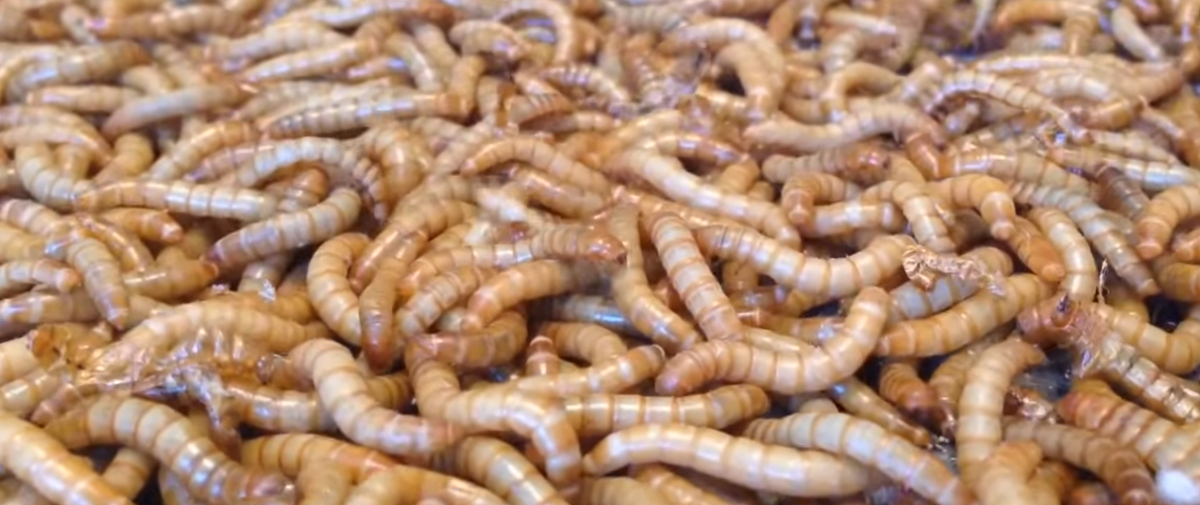
Your backyard flock will love both dried and fresh Mealworms and they make a excellent treat, bribery titbit and training aid. It is important to note that Mealworms are expensive to buy and are not a must have in chicken keeping. You can get by fine without them.
Below: Chickens eating mealworms.

Mealworms aren't really worms, they are brown worm-like larvae of the darkling beetle. They are the second of four stages of life and exist to eat and grow until they have enough energy stored to begin transformation into pupae and then beetles
Mealworms are an important part of the ecosystem. Voracious eating habits aid in the decomposition and cleanup of unwanted organic matter.
Below: Chickens love mealworms.
These insects are also an important food source for many animals and serve as a favourite treat for birds in their natural habitat.
Chickens also consider them irresistible. They are quite easy to produce yourself and can be cheap if you raise Mealworms on your family waste.
Can chickens eat Mealworms?
Chickens can and will eat Mealworms. In fact they love them. All the chickens I know will eat as many insects as they can and Mealworms are no exception.
Below: Chickens eating Mealworms.
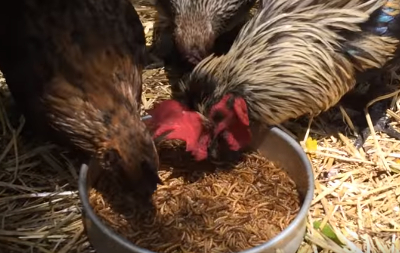
Chickens will eat any amount you provide.
Do chickens like Mealworms?
Oh yes. Chickens love insects and Mealworms are no exception. They will snatch them out of your fingers once the realise what you have got for them.
A whole industry, both small scale cottage type production as well as large scale commercial production, has sprung up to supply Mealworms.
Are Mealworms good for chickens?
Yes, in moderation, but in reality not as good as you might think. Mealworms should never be more than a treat for your hens and must always be less than 5% of the diet. There is nothing wrong with treats in moderation.
Fresh are better than dried. Dried Mealworms are almost completely protein and fat and more than a few can upset the balance of nutrients in the hens diet and cause problems with the digestive system and the eggs.
Hens do not need more than 16% protein in the diet.
They make an excellent supplementary addition to the diet during the moult when your backyard flock will need a little extra protein.
Should I feed live Mealworms?
Chickens can and will eat both live and dead or dried Mealworms. It makes little difference to them.
Below: Live mealworms.
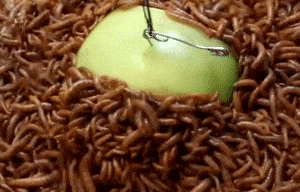
With around 50% protein when dried and 30% protein when fed alive, they are packed with protein and fats. The protein content of live worms is slightly of a problem from a health point of view. Dried ones aren’t a problem if fed in moderation.
I personally would go with live and it goes without saying that you should never feed poultry food that is rotten, decaying or mouldy.
What about ducks, geese, turkey's and guinea fowl?
You can feed ducks, turkeys and guinea fowl Mealworms. These are all poultry types that actively hunt insect life.
Geese are grazers primarily and will benefit little from the expense of Mealworms in their diet.
How many Mealworms do you feed chickens?
No more than 4 dried or 10 live Mealworms should be given to a chicken in any one day. Mealworms are easily digested and should be given in the morning or earlier in the day.
Below: Just feed your hens a few Mealworms every second day.

10 large Mealworms per standard size chicken, 3 times per week. Less for bantams.
Over-feeding high fat Mealworms can cause fatty liver disease in chickens and the protein content can cause all sorts of egg and kidney related problems.
Why can't chickens have Mealworms?
Feeding them in the evening or just before roosting time can leave the birds hungry overnight. Birds digestive systems are active overnight and the last feed should be filling and energy dense to make the most of the resting hours. This is one way it can effect egg production as the chickens are roosting with empty crops for long periods.
In some places around the world it is illegal to feed any mass produced insect protein to poultry. If you sell or give away your surplus eggs to anyone you must not feed them Mealworms or insect protein. You could be liable if they get ill!
It may be illegal in some countries to feed bought mealworms to chickens.
What about Mealworms for chicks?
Baby chickens raised in a brooder may benefit from insects. It is after all a food they would find if they were raised naturally under a broody hen.
It is also a good ways of training baby chickens as the mother hen will bring her babies to you for Mealworms.
How to Raise Mealworms for chickens:
Mealworms of different types can be found in most areas of the world. They prefer warm, dark, and damp places like under decaying logs and leaves and will die quickly in dry conditions. Designed for burrowing and consuming grains, vegetation, spoiled food, and many other types of fresh or decaying organic matter.
Below: You start with Darkling Beetles.
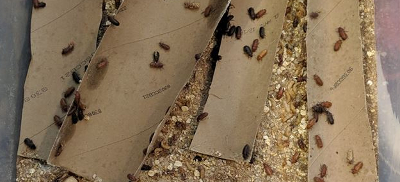
Below: And end up with Mealworms.
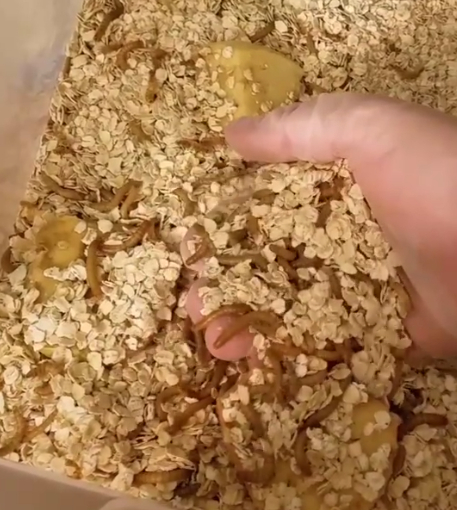
Raising Mealworms is fairly easy since they are prolific breeders and are hardy insects.
It is also fairly inexpensive and can save you quite a bit of money if you use a lot of worms every month.
They occasionally smell, are mostly easy to care for, and take 2 hours a week or so to look after.
What do you need to raise Mealworms for chickens?
They are also easy to raise and reproduce in large numbers. A female darkling beetle can lay hundreds of eggs.
1. Plastic tote or drawer. The container should have a large surface area and smooth sides. The sides of the container only need to be a couple inches higher the substrate in order to prevent the worms from escaping. An aquarium, terrarium, plastic box
2. Food Substrate. Like a wheat bran substrate.The substrate of the container will be the food. You can use wheat bran, oatmeal, cornmeal, wheat flour, Wheaties, Cheerios, ground up dry dog food, or a mixture of these dry foods. Fill the bottom of the container two or three inches deep with the food substrate. You will have to add more food regularly since Mealworms are big eaters.
3. White paper towels for hiding, shading and misting with water to increase humidity. Card egg boxes work as well.
4. Extra light is not necessary. A normal day and night cycle of light will be fine. Sunshine will kill your mealworm colony so keep out of direct sun.
5. Beetles and larvae need a moisture source, like a fruit or veggies. Apple slices and carrots for food/moisture. Slices of potatoes, apples, carrots, lettuce, cabbage, or other fruits and vegetables can supply water to your worms. Potatoes are often preferred since they last a while and do not mould quickly.
Do not use a bowl of water since Mealworms will crawl in and drown.
Warm and dark spot. 75-85 degrees.I had mine in those plastic 4 drawer units you get at Walmart cheap, worked perfect for me.
To move them to new bedding, I sift beetles and bedding through a slotted colander
Maintenance of the mealworm colony:
Any dead worms, pupae, or beetles should be removed from the container regularly.
If the container begins to smell like ammonia or starts growing mould it is time to move the worms to a new container and clean up.
Below: The beetle stage of the life cycle.
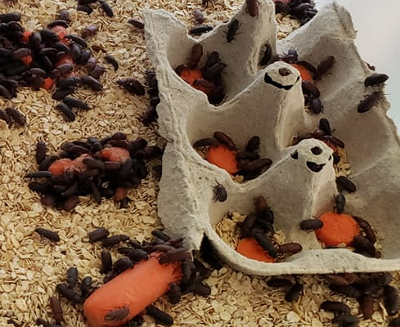
You will need to move all of the Mealworms, beetles, and pupae, discard the food and waste, and clean the container. Once clean, replace the bran or substrate and return the insects to the container. What you take out can be put in the compost pile.
It is helpful to have a second or third container to aid in raising Mealworms and keeping them odour free. After your colony is stable, you can move any beetles to the second container and start a new colony to give you a more consistent supply.
By the time the second colony is established, the original container should have very few Mealworms. You can move any remaining worms to the second container and the original container can then be cleaned and prepared to repeat the cycle.
You can feed Mealworms sweet potatoes, banana peels, carrots and any vegetable waste you have.
Below: Mealworms devouring apple slices.

The ideal temperature for growing your colony is around 75 degrees F. A heat emitter may be necessary if you are in a cold climate. You will want to keep the container away from windows and direct sunlight to prevent it from becoming too warm.
Light is not necessary. A normal day and night cycle of light will be fine.
You colony of Mealworms will reproduce more quickly with a higher humidity, but for most areas the natural humidity in the air will be sufficient. If you live in a dry climate, you can place a smooth glass or bowl of water into the container to raise the humidity.
Every day just mist a piece of kitchen towel a little. They need high humidity.
They shed their skins and shed a few times. White worms means they are newly moulted. It will turn dark before it changes.
How much does it cost to produce Mealworms?
They are not expensive to breed, it depends on how many you produce and the time factor. If you do small scale with your own waste the costs are small. if you have to buy feed and substrate then the cost will increase.
Most people I know use carrots and or potatoes as a moisture source.
There are several materials you can use as a substrate, wheat bran seems to be the most popular. It's easier to sift.
The containers are your biggest initial expense. Everybody does this a little differently, depending on their yield requirements and the time they want to spend looking after them.
The cost adds up, especially to get started for large scale production. It hurts less if you gradually build up.
If you pick up a pupae by the tail, they will squirm. If they are turning dark or black, they are dead.
If their colour is still rather creamy, I leave them be, even if they do not squirm. The legs will start to get dark or black when they are close to emerging as a beetle.
What temperature do Mealworms need?
The ideal is 75F and dark. Stable temperatures are best .Dark is good but a normal pattern of day and night is fine.
Temps 75-77F is best but 70F-72F works, or normal household temperature. Some people raise outdoors in certain climates, but, pests are a concern, especially mice, spiders, and ants.
How much time do Mealworms need to be ready?
Mealworms take 6-9 months to be ready if you want sustainable production. Lower temps of below 72 will take longer and higher temps 74-80 will be quicker.
Whats is the best humidity level for Mealworms?
55% humidity is ideal but stay under 65%. To high may condense and promote decay and clagginess in the substrates. Again stable humidity is best even if it is outside the ideal range a little.
How do you keep or store Mealworms?
You can keep Mealworms fresh in one of two ways:
- In the fridge - Live Mealworms can be stored in a refrigerator for up to 3 months. All you have to do is take them out of the refrigerator about once a week and give them some warmth and food for a few hours.
- You dry your own Mealworms. Dried Mealworms are freeze dried or slowly oven dried or desiccated in a food dryer. Dried worms usually float which can make them a great treat for ducks.
Notice I said "A REFRIGERATOR" I would advise against letting a spouse or partner stumble across a pot of insects in the kitchen fridge!
Alternatively if you buy mealworms then just reseal the bag until you need them again.
Drying to factory quantity requires a commercial dryer, which are expensive. Mealworms can be dried outside. Baking or drying them inside is very stinky even in a food dryer or home dehydrator.
Freeze drying Mealworms is simple at home. Place on a tray and freeze without covering for a few days. Then place in a food dehydrator to finish the process.
This should be done in a garage or outdoor kitchen or workshop.
What are the problems with raising Mealworms for chickens?
- The worms are like vampires. If he get direct sunlight they die fast. I learnt the hard way.
- It takes a long time to raise Mealworms, around 9 months to sustainable harvest.
- Raising Mealworms for chickens is an involved process that takes time.
- It can cost considerable money to set up and if you are using more than your family waste the food will cost as well.
- Mealworms become flying Beatles. Doesn't it make more sense to grow a different type of worm that isn't going to fly away?
- The cold is a problem. When winter hits my colony they slow down. Its called Torpor a state of no mental or physical activity. Some of the beetles will die but the worms and pupa will not they will survive winter and continue to produce when temps rise back to the 70's.
Where to buy mealworms?
Bulk is the cheapest way to buy in the long run:
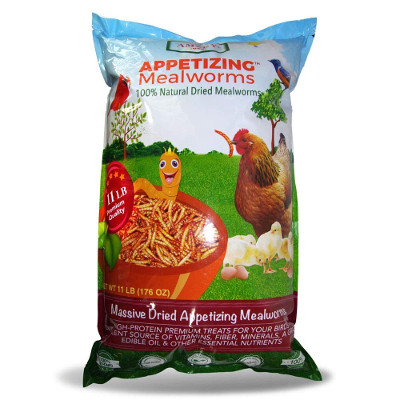
If you live in the US, I recommend these 100% natural non-GMO Mealworms from appetizing. Available from Amazon.
From Amazon UK - a 5 Litre tub - Other sizes are available.
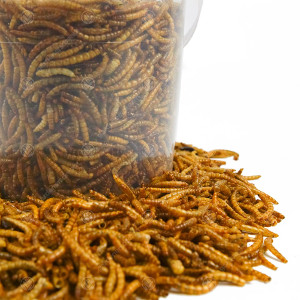
You can also try Facebook groups and garden centres for Mealworms.
